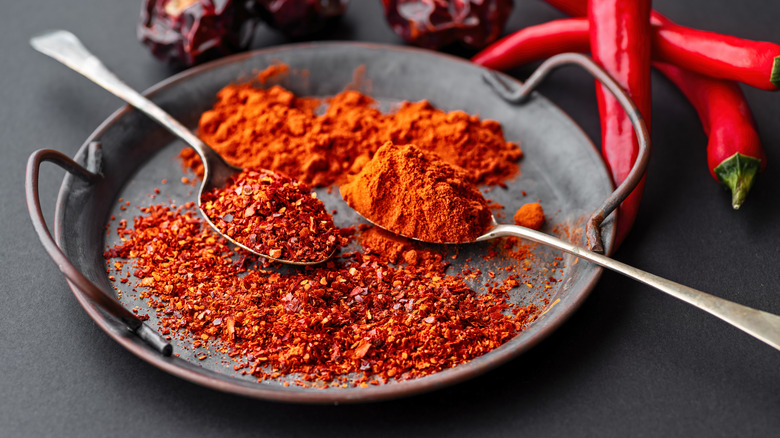The Spices You Should Turn To When Substituting Paprika
Let's face it: the spice rack can be overwhelming. Even if it's organized neatly and labeled, navigating the kaleidoscope of aromas and colors is tricky. And say you're already cooking, and a spice runs out — well with some savviness, such stress can be resolved spontaneously. So if Hungarian or Spanish fare is on the menu and the paprika's gone, then no fear; there's a range of available substitutions.
First of all, it's helpful to remember what exactly paprika is made from. This powdered spice comes from the many varieties of the Capsicum annuum species — what we call bell peppers, poblanos, jalapenos and more in raw form. Subsequently, the resultant flavor covers a broad palate from spicy to sweet and smokey, defined not only by the employed fruit, but the processing method, too. Regardless of the type, a bright vibrant color is a unifying quality.
So, you'll need to consider the paprika required in the dish to make the ideal substitution. The logical starting point is other forms of powdered peppers like chipotle or chili powder. However, there are other clever options like tomato powder or even ground cinnamon. So dig into the many possibilities to satisfy the culinary swap with the tastiest result.
Other powdered chiles and warm spices are the ideal paprika substitute
To start, check your drawer for another spice composed of ground chiles; it'll dependably offer the best replacement. If you have chili powder on hand, that's ideal. Although the mix also contains additions like oregano, cumin, and onion powder, paprika remains in the ingredient list. So sure, you'll lessen the pepper-notes in a dish, but still bring a complex earthiness. It's especially helpful when the food calls for a mild paprika alongside other aromatics, like in a marinade, stew, or sauce.
Meanwhile, if your dish necessitates a smoked paprika — say you're making a shortcut aioli for Spanish-inspired tuna patties — then it's best to turn to Mexican chiles. Chipotle powder is a great candidate, especially if mixed in with a bit of sugar to smoothen its kick. On the other hand, ancho or pasilla provides a more subtle flavor, and if you don't mind a sharper flavor, then guajillo's are the move. And if heat is the goal, then trusty cayenne's available.
It's a little trickier to replace the distinct flavor and color of sweet paprika, commonly utilized in European cuisine. Typically crafted from pimentos, not to be confused with roasted red peppers, this variety comes especially fruity. A savvy swap is tomato powder, which brings a reminiscent type of fruitiness. And while your resultant dish will taste different, the sweetness of spices like cinnamon, ginger, and cloves can help compensate for a lack of paprika.

